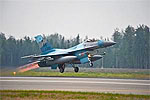Spared from sequestration cuts, Red Flag-Alaska wraps up
 U.S. and international troops spent much of August flying simulated combat sorties at Red Flag in Alaska, one training exercise allowed to continue despite sequestration budget cuts.
U.S. and international troops spent much of August flying simulated combat sorties at Red Flag in Alaska, one training exercise allowed to continue despite sequestration budget cuts.
Red Flag-Alaska 13-3, which wrapped up Aug. 23, involved 60 aircraft and 2,600 people. The group included Air Force, Navy and Marine Corps troops, and military members from South Korea, Japan and Australia.
The training marked the first time Korean and Japanese forces trained together in Alaska or anywhere. The Republic of Korea Air Force brought F-15K Slam Eagles, with the Japanese Air Self-Defense Force flying its own version of the F-15 Eagle. Flights began Aug. 8 for the exercise.
“The exercise provides unique opportunities to integrate various forces into joint and coalition training from simulated forward operating bases,” said Capt. Joost Verduyn, chief spokesman of the 354th Figther Wing at Eielson Air Force Base, which played host for the training.
The training let the participants simulate combat in a “realistic threat environment,” he said.
The Air Force part of the training included representatives from active duty, Air National Guard and Air Force Reserve, including F-15s, F-16s, F-22s and A-10s, along with KC-135s, KC-130s and F/A-18s.
The training involved “red” aggressor forces, “blue” coalition forces and “white” forces, agroup that acts like a referee to oversee and control the exercises made up of the 353rd Combat Training Squadron at Eielson. The training took place at the 67,000-square-mile Joint Pacific Alaska Range Complex.
The training came as Pacific Air Forces slowed down its training abroad, canceling or curtailing involvement due to mandatory budget cuts. While this Red Flag continued, the Air Force canceled its involvement in exercises in the Philippines and Singapore, and cut back on exercises and expositions in Thailand, Malaysia, Cambodia and Australia. Participation in each event was reviewed “case by case” to ensure readiness, according to PACAF.
This year, the Air Force was forced to stand down 16 combat-coded squadrons due to sequestration, including F-16s of Eielson’s 18th Aggressor Squadron. The service kept its funding for aircraft assigned to U.S. Pacific Command, and was able to return the aircraft to full readiness after Congress approved a $208 million reprogramming request for more flying hours.